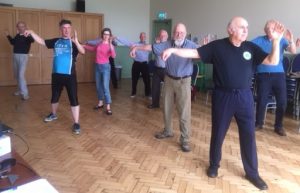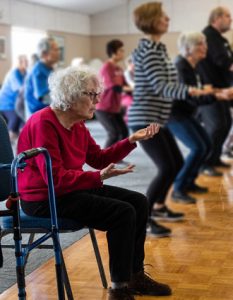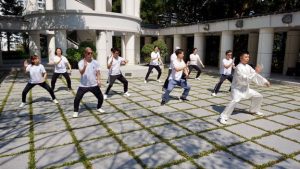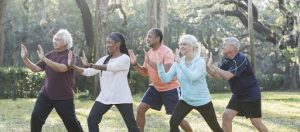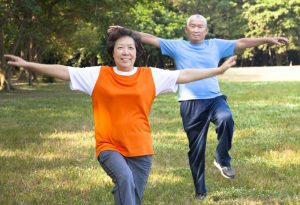Improve the Respiratory Symptoms of Lung Cancer Patients with Qigong Practice
By John M. de Castro, Ph.D.
“Studies show that qigong practice can have many positive effects, particularly among patients with cancer, chronic illnesses, and breathing problems, as well as older adults. Benefits include improved lung function, mood, sleep, and quality of life, as well as reduced stress, pain, anxiety, and fatigue.” – Sloan Kettering Institute
Receiving a diagnosis of cancer has a huge impact on most people. Feelings of depression, anxiety, and fear are very common and are normal responses to this life-changing and potentially life-ending experience. But cancer diagnosis is not necessarily a death sentence. Over half of the people diagnosed with cancer are still alive 10 years later and this number is rapidly increasing. But, surviving cancer carries with it a number of problems. Anxiety, depression, fatigue and insomnia are common symptoms in the aftermath of surviving cancer. These symptoms markedly reduce the quality of life of the patients.
Mindfulness training has been shown to help with cancer recovery and help to alleviate many of the residual physical and psychological symptoms, including stress, sleep disturbance, and anxiety and depression. Tai Chi or Qigong practice has been shown to improve quality of life, reduce fatigue, and lower blood pressure and cortisol levels. They are very gentle and safe practices. The research on the effectiveness of Qigong training for lung cancer patients is sparse. So, it makes sense to Investigate the ability of Qigong training to improve the symptoms of lung cancer.
In today’s Research News article “The Effectiveness of Qigong in Managing a Cluster of Symptoms (Breathlessness-Fatigue-Anxiety) in Patients with Lung Cancer: A Randomized Controlled Trial.” (See summary below or view the full text of the study at: https://www.ncbi.nlm.nih.gov/pmc/articles/PMC8047940/ ) Molassiotis and colleagues recruited patients who had complete treatment for lung cancer and randomly assigned them to either a wait-list control group or to engage in Qigong practice. They were trained in Qigong in 2 weekly 90-minute practices for 2 weeks and then practiced Qigong at home for 30 minutes per day, 5 days per week, for 4 weeks. They were measured before and after training and at 12 weeks for disease status, fatigue, dyspnea (difficulty with breathing), anxiety, depression, cough frequency intensity and bothersomeness, and quality of life.
They found that in comparison to baseline the group that practiced Qigong had significant reductions in fatigue, dyspnea (difficulty with breathing), anxiety, and cough score that were maintained at the 12-week follow-up. These effects were significantly greater in men than in women. Hence, Qigong practice appeared to improve the symptoms in lung cancer patients.
It should be noted that 2 weeks of Qigong training followed by 4 weeks of home practice is a rather low amount of practice relative to what is usually prescribed in other controlled research, as much as 6 months of practice. In addition, only 62% of the Qigong group completed the practice with a 62% adherence rate. So, the effective dose of Qigong was low. This suggests that if practice was extended over longer periods of time greater effectiveness would have been observed. Nevertheless, Qigong practice, even in low dose, had positive benefits for lung cancer patients.
So, improve the respiratory symptoms of lung cancer patients with Qigong practice.
“Qigong improved physical and mental well-being as well as quality-of-life in patients with lung cancer.” – Patient Power
CMCS – Center for Mindfulness and Contemplative Studies
This and other Contemplative Studies posts are also available on Google+ https://plus.google.com/106784388191201299496/posts and on Twitter @MindfulResearch
Study Summary
Molassiotis, A., Vu, D. V., & Ching, S. (2021). The Effectiveness of Qigong in Managing a Cluster of Symptoms (Breathlessness-Fatigue-Anxiety) in Patients with Lung Cancer: A Randomized Controlled Trial. Integrative cancer therapies, 20, 15347354211008253. https://doi.org/10.1177/15347354211008253
Abstract
Background and Purpose:
Qigong is used by cancer patients, but its effect is not adequately evaluated to date. The aim of this study was to investigate the effects of Qigong for the management of a symptom cluster comprising fatigue, dyspnea, and anxiety in patients with lung cancer.
Methodology:
A total of 156 lung cancer patients participated in this trial, and they were randomized to a Qigong group (6 weeks of intervention) or a waitlist control group receiving usual care. The symptom cluster was assessed at baseline, at the end of treatment (primary outcome), and at 12 weeks, alongside measures of cough and quality of life (QOL).
Results:
There was no significant interaction effect between group and time for the symptom cluster overall and for fatigue and anxiety. However, a significant trend towards improvement was observed on fatigue (P = .004), dyspnea (P = .002), and anxiety (P = .049) in the Qigong group from baseline assessment to the end of intervention at the 6th week (within-group changes). Improvements in dyspnea and in the secondary outcomes of cough, global health status, functional well-being and QOL symptom scales were statistically significant between the 2 groups (P = .001, .014, .021, .001, and .002, respectively).
Conclusion:
Qigong did not alleviate the symptom cluster experience. Nevertheless, this intervention was effective in reducing dyspnea and cough, and improving QOL. More than 6 weeks were needed, however, for detecting the effect of Qigong on improving dyspnea. Furthermore, men benefited more than women. It may not be beneficial to use Qigong to manage the symptom cluster consisting of fatigue, dyspnea, and anxiety, but it may be effective in managing respiratory symptoms (secondary outcomes needing further verification in future research). Future studies targeting symptom clusters should ensure the appropriateness of the combination of symptoms.
https://www.ncbi.nlm.nih.gov/pmc/articles/PMC8047940/


